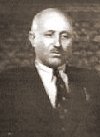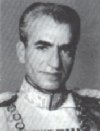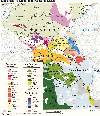| South
Azerbaijan (Guney Azerbaycan) |
Azerb.com
|
| |
|
 South
Azerbaijan comprises three provices currently part of the Islamic Republic
of Iran: Western Azerbaijan, with its capital in Uromiyeh,
Eastern Azerbaijan, with its capital in Tabriz
and Ardebil, whose capital is also
called Ardebil. A forth Iranian province Zanjan,
with the capital in the city of the same name, also has a dominant Azeri
population and there are important Azeri communities in and around Hamadan,
in Tehran, around Qom and Saveh, in the Khorasan province, and are scattered
throughout many other parts of Iran. The most conservative
numbers point to 13 million Azeris in Iran (often called 'Tork'),
but more realistic estimates indicate about 30 million speakers in the
Islamic Republic.
South
Azerbaijan comprises three provices currently part of the Islamic Republic
of Iran: Western Azerbaijan, with its capital in Uromiyeh,
Eastern Azerbaijan, with its capital in Tabriz
and Ardebil, whose capital is also
called Ardebil. A forth Iranian province Zanjan,
with the capital in the city of the same name, also has a dominant Azeri
population and there are important Azeri communities in and around Hamadan,
in Tehran, around Qom and Saveh, in the Khorasan province, and are scattered
throughout many other parts of Iran. The most conservative
numbers point to 13 million Azeris in Iran (often called 'Tork'),
but more realistic estimates indicate about 30 million speakers in the
Islamic Republic.
The 3 provinces that make South Azerbaijan
represent about 30 percent of the Iranian land mass, an area larger than
the Republic of Azerbaijan itself. The population, estimated at around
10 million is also bigger.
 The
separation of south and north was made permanent with the treaty of Turkmanchay,
signed between Russia and Persia in 1828. The Azeris north of the river
Araz were left inside the Russian empire, and apart from brief periods
of anarchay stayed with Russian until the breakup of the Soviet Union,
when north-Azerbaijan became independent as the Republic of Azerbaijan.
Those south of the Araz remain today part of the Islamic Republic of Iran,
which suceeded to the Persian monarchy.
The
separation of south and north was made permanent with the treaty of Turkmanchay,
signed between Russia and Persia in 1828. The Azeris north of the river
Araz were left inside the Russian empire, and apart from brief periods
of anarchay stayed with Russian until the breakup of the Soviet Union,
when north-Azerbaijan became independent as the Republic of Azerbaijan.
Those south of the Araz remain today part of the Islamic Republic of Iran,
which suceeded to the Persian monarchy.
 The
two halves of the country were last briefly together during World War II,
when Stalin with the support of the western allies occupied the north of
Iran and tried to create a "Democratic Republic of Azerbaijan", using a
mix of nationalist and communist ideals. However, after the end of the
war international pressure on the Soviet Union to leave mounted and the
Red Army retreated to the norhern bank of the Araz.
The
two halves of the country were last briefly together during World War II,
when Stalin with the support of the western allies occupied the north of
Iran and tried to create a "Democratic Republic of Azerbaijan", using a
mix of nationalist and communist ideals. However, after the end of the
war international pressure on the Soviet Union to leave mounted and the
Red Army retreated to the norhern bank of the Araz.
 The
Democratic Republic of Azerbaijan led by Jafar Pishevari was left at the
mercy of the Iranian army and soon collapsed. Many in the south Azeri intelligentsia
escaped to the north, fuelling a movement for reunification which didn't
displease the Soviet authorities. The continuation of the Pishevari republic
was unthinkable for the Iranian government headed by Ghavam Sultaneh, particularly
after Pishevari reached an alliance with the Kurdish independentists of
the Mahabad republic.
The
Democratic Republic of Azerbaijan led by Jafar Pishevari was left at the
mercy of the Iranian army and soon collapsed. Many in the south Azeri intelligentsia
escaped to the north, fuelling a movement for reunification which didn't
displease the Soviet authorities. The continuation of the Pishevari republic
was unthinkable for the Iranian government headed by Ghavam Sultaneh, particularly
after Pishevari reached an alliance with the Kurdish independentists of
the Mahabad republic.
This short period of shared history reinforced
the links between the two areas, creating a culture of "longing" for reunification,
reflected in literature, music and ever more on the political speech of
some sectors on both sides of the border. The fact that the red army acted
in an unusually correct way towards the population while the returning
Iranian army committed all sorts of crimes also contributed to this ambition.
 After
returning to Iranian sovereignty, Azeris had the use of their language
banned, under Shah Mohammad
Reza Pahlevi, until the advent of the
islamic revolution of 1979. However after 1983, with the consolidation
of the Ayatollah's regime the calls for autonomy were suppressed and several
publications in the Azeri language were closed.
After
returning to Iranian sovereignty, Azeris had the use of their language
banned, under Shah Mohammad
Reza Pahlevi, until the advent of the
islamic revolution of 1979. However after 1983, with the consolidation
of the Ayatollah's regime the calls for autonomy were suppressed and several
publications in the Azeri language were closed.
In the last years of the soviet union the
demonstrations in the ASSR in favour of closer links with south Azerbaijan
were frequent, reaching even the point of burning the border fences.
 Paradoxically,
with the independence of the Republic of Azerbaijan, the question of South
Azerbaijan became less important in Baku, as the conflict with Armenia
took to centre stage. Although former president Elchibey made some remarks
on reunification, during recent years the Azeri government hasn't raised
the issue with Iran, since for the Republic of Azerbaijan it is obviously
better to have Iran as a friend.
Paradoxically,
with the independence of the Republic of Azerbaijan, the question of South
Azerbaijan became less important in Baku, as the conflict with Armenia
took to centre stage. Although former president Elchibey made some remarks
on reunification, during recent years the Azeri government hasn't raised
the issue with Iran, since for the Republic of Azerbaijan it is obviously
better to have Iran as a friend.
In Iran, ethnic Azeris have a history of
being well integrated into the highest power structures – Supreme Leader
Ayatollah Khamenei, for one, is Azeri – as well as a legacy of frequently
pushing the Iranian government hard on its policies.
 The
current nationalist movement, which has gathered strength since Azerbaijan's
emergence, has been hamstrung by an internal lack of unity and threats
from the Iranian government. Currently the main voice for the Azeri population
in the Islamic Republic is the National Liberation Movement of Southern
Azerbaijan (NLMSA), headed by Piruz Dilenchy. The organization was
created in 1996, when six Azeri political parties merged. The Iranian government
has accused Turkey of being involved with the NLMSA. The movement is quite
vocal in it struggle and has organized several demonstrations recently,
mainly in Tabriz, which were violently broke up by the Iranian police.
The
current nationalist movement, which has gathered strength since Azerbaijan's
emergence, has been hamstrung by an internal lack of unity and threats
from the Iranian government. Currently the main voice for the Azeri population
in the Islamic Republic is the National Liberation Movement of Southern
Azerbaijan (NLMSA), headed by Piruz Dilenchy. The organization was
created in 1996, when six Azeri political parties merged. The Iranian government
has accused Turkey of being involved with the NLMSA. The movement is quite
vocal in it struggle and has organized several demonstrations recently,
mainly in Tabriz, which were violently broke up by the Iranian police.
 Recently
the Azeri population and the Iranian authorities have clashed over the
election of Mahmood-Ali Chehregani to the Teheran parliament. He is an
outspoken defender of Azeri rights and an opposer to forced 'Persianization'
of South Azerbaijan. The Iranian authorities have barred him from taking
his seat in parliament and have even been accused of torture.
Recently
the Azeri population and the Iranian authorities have clashed over the
election of Mahmood-Ali Chehregani to the Teheran parliament. He is an
outspoken defender of Azeri rights and an opposer to forced 'Persianization'
of South Azerbaijan. The Iranian authorities have barred him from taking
his seat in parliament and have even been accused of torture.
The US has tried to tap into those ethnic
tensions as a possible pressure point for promoting change within Iran.
The Americans established an "Office of Iranian Affairs"; committed $75
million to promoting democracy in Iran; installed an "Iran watcher"
in Baku, as well as other cities near Iran; and helped Azerbaijan build
a radar station on the Iranian border for the stated purpose of monitoring
the Caspian Sea.
 If
you are going to visit South Azerbaijan probably you will need an Iranian
Visa (if you are European you can get it at the border without
an invitation).
If
you are going to visit South Azerbaijan probably you will need an Iranian
Visa (if you are European you can get it at the border without
an invitation).
| A to Z of Azerbaijan
/ A dan Z ye Azerbaycan |
www.azerb.com
|
 The
separation of south and north was made permanent with the treaty of Turkmanchay,
signed between Russia and Persia in 1828. The Azeris north of the river
Araz were left inside the Russian empire, and apart from brief periods
of anarchay stayed with Russian until the breakup of the Soviet Union,
when north-Azerbaijan became independent as the Republic of Azerbaijan.
Those south of the Araz remain today part of the Islamic Republic of Iran,
which suceeded to the Persian monarchy.
The
separation of south and north was made permanent with the treaty of Turkmanchay,
signed between Russia and Persia in 1828. The Azeris north of the river
Araz were left inside the Russian empire, and apart from brief periods
of anarchay stayed with Russian until the breakup of the Soviet Union,
when north-Azerbaijan became independent as the Republic of Azerbaijan.
Those south of the Araz remain today part of the Islamic Republic of Iran,
which suceeded to the Persian monarchy.
 South
Azerbaijan comprises three provices currently part of the Islamic Republic
of Iran: Western Azerbaijan, with its capital in Uromiyeh,
Eastern Azerbaijan, with its capital in Tabriz
and Ardebil, whose capital is also
called Ardebil. A forth Iranian province Zanjan,
with the capital in the city of the same name, also has a dominant Azeri
population and there are important Azeri communities in and around Hamadan,
in Tehran, around Qom and Saveh, in the Khorasan province, and are scattered
throughout many other parts of Iran. The most conservative
numbers point to 13 million Azeris in Iran (often called 'Tork'),
but more realistic estimates indicate about 30 million speakers in the
Islamic Republic.
South
Azerbaijan comprises three provices currently part of the Islamic Republic
of Iran: Western Azerbaijan, with its capital in Uromiyeh,
Eastern Azerbaijan, with its capital in Tabriz
and Ardebil, whose capital is also
called Ardebil. A forth Iranian province Zanjan,
with the capital in the city of the same name, also has a dominant Azeri
population and there are important Azeri communities in and around Hamadan,
in Tehran, around Qom and Saveh, in the Khorasan province, and are scattered
throughout many other parts of Iran. The most conservative
numbers point to 13 million Azeris in Iran (often called 'Tork'),
but more realistic estimates indicate about 30 million speakers in the
Islamic Republic.
 The
two halves of the country were last briefly together during World War II,
when Stalin with the support of the western allies occupied the north of
Iran and tried to create a "Democratic Republic of Azerbaijan", using a
mix of nationalist and communist ideals. However, after the end of the
war international pressure on the Soviet Union to leave mounted and the
Red Army retreated to the norhern bank of the Araz.
The
two halves of the country were last briefly together during World War II,
when Stalin with the support of the western allies occupied the north of
Iran and tried to create a "Democratic Republic of Azerbaijan", using a
mix of nationalist and communist ideals. However, after the end of the
war international pressure on the Soviet Union to leave mounted and the
Red Army retreated to the norhern bank of the Araz.
 The
Democratic Republic of Azerbaijan led by Jafar Pishevari was left at the
mercy of the Iranian army and soon collapsed. Many in the south Azeri intelligentsia
escaped to the north, fuelling a movement for reunification which didn't
displease the Soviet authorities. The continuation of the Pishevari republic
was unthinkable for the Iranian government headed by Ghavam Sultaneh, particularly
after Pishevari reached an alliance with the Kurdish independentists of
the Mahabad republic.
The
Democratic Republic of Azerbaijan led by Jafar Pishevari was left at the
mercy of the Iranian army and soon collapsed. Many in the south Azeri intelligentsia
escaped to the north, fuelling a movement for reunification which didn't
displease the Soviet authorities. The continuation of the Pishevari republic
was unthinkable for the Iranian government headed by Ghavam Sultaneh, particularly
after Pishevari reached an alliance with the Kurdish independentists of
the Mahabad republic.
 After
returning to Iranian sovereignty, Azeris had the use of their language
banned, under Shah Mohammad
Reza Pahlevi, until the advent of the
islamic revolution of 1979. However after 1983, with the consolidation
of the Ayatollah's regime the calls for autonomy were suppressed and several
publications in the Azeri language were closed.
After
returning to Iranian sovereignty, Azeris had the use of their language
banned, under Shah Mohammad
Reza Pahlevi, until the advent of the
islamic revolution of 1979. However after 1983, with the consolidation
of the Ayatollah's regime the calls for autonomy were suppressed and several
publications in the Azeri language were closed.


